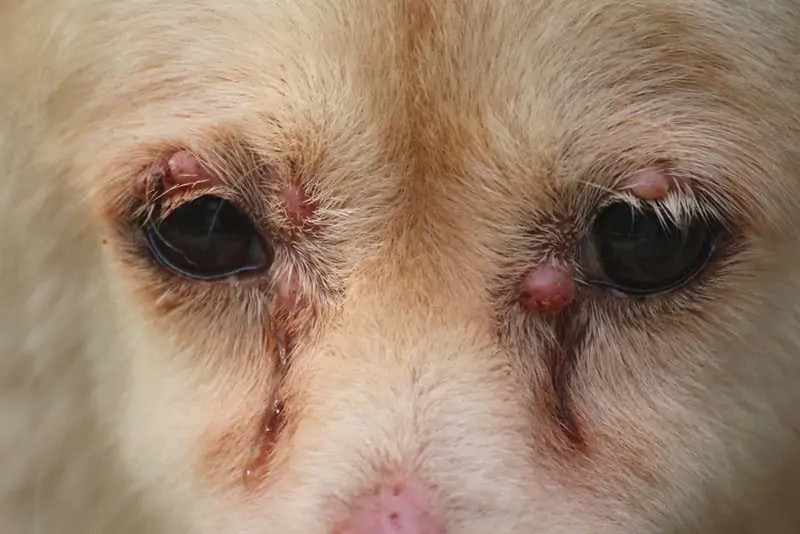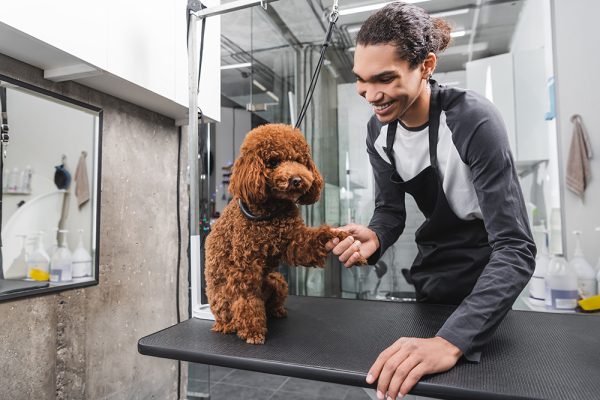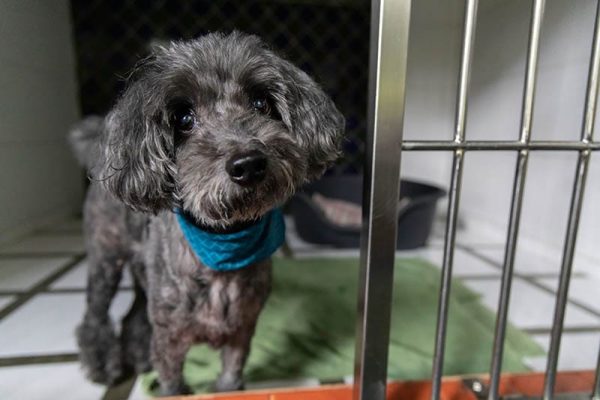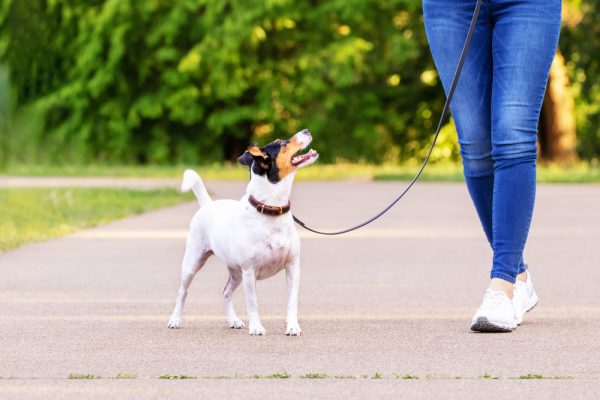As dogs age, they may start to get lumps and bumps all over their body. You may even start to notice bumps on your dog’s eyelids and/or around the eye itself. There are many reasons why your dog may develop a black, blood-filled bump on their eye. Most of these will develop as your dog gets older, but we can see them at any age. Continue reading to find out what these bumps may be, what causes them and how you should care for them.

What Are the Signs of a Bump on My Dog’s Eye?
At first, you may not notice anything unusual. Your dog may have a small swelling along their upper or lower eyelid that is difficult to see. As the swelling grows, you may then start to notice an actual growth on the eyelid. Other times, it just appears as if the eyelid itself has a swollen area.
The conjunctiva, or the pink tissue you see, lines the areas underneath the eyelid and may become inflamed. You may notice the conjunctiva appear swollen, dark pink and even puff out from beneath the upper or lower eyelids. You may also notice increased tearing to that eye.
Sometimes the growth will grow inwards, or rub on the cornea, or the surface of the eye. Every time your dog blinks, the cornea will then be irritated by the growth rubbing on it. This can be extremely painful and you may notice your dog squinting that eye, holding the eye shut and/or rubbing at the eye because of the pain.
Furthermore, a growth may even cause a corneal abrasion or corneal ulcer to the eye, which is erosion of layers of the cornea. Depending on how deep the irritation is will determine if it’s just an erosion or if it’s an ulcer.
If your pet is showing these signs, we suggest you speak to a vet.
If you need to speak with a vet but can't get to one, head over to PangoVet. It's an online service where you can talk to a vet online and get the personalized advice you need for your pet — all at an affordable price!

The Causes of the 5 Types of Bumps on Dog’s Eye
1. Chalazion
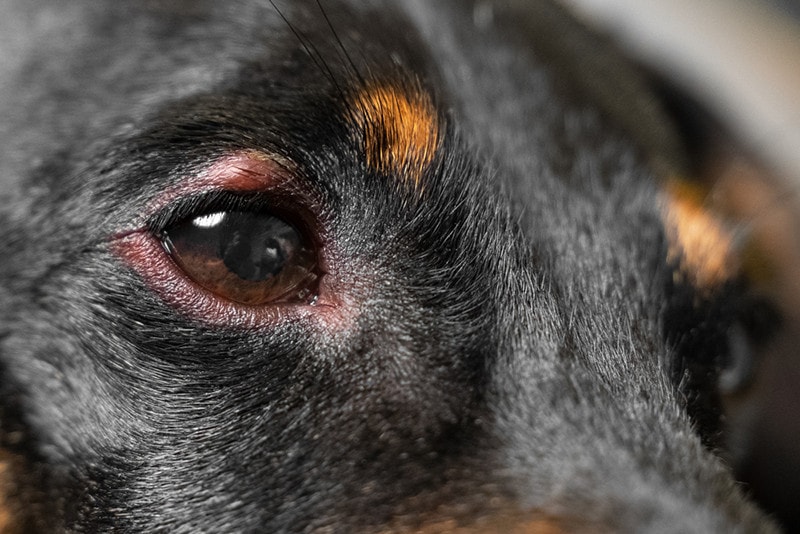
A chalazion is a non-cancerous swelling of the eyelid caused by a blocked meibomian gland. Meibomian glands are found along the eyelid margin and are associated with the eyelashes. They secrete an oil which helps lubricate the eye with the tears.
After oily secretions from the gland become stuck or blocked from coming out, it will cause chronic inflammation and swelling of the gland as these oils build up. While a chalazion appears as a growth, it’s just from one or a few of the glands being blocked and aren’t an actual mass.
2. Meibomian Gland Tumors
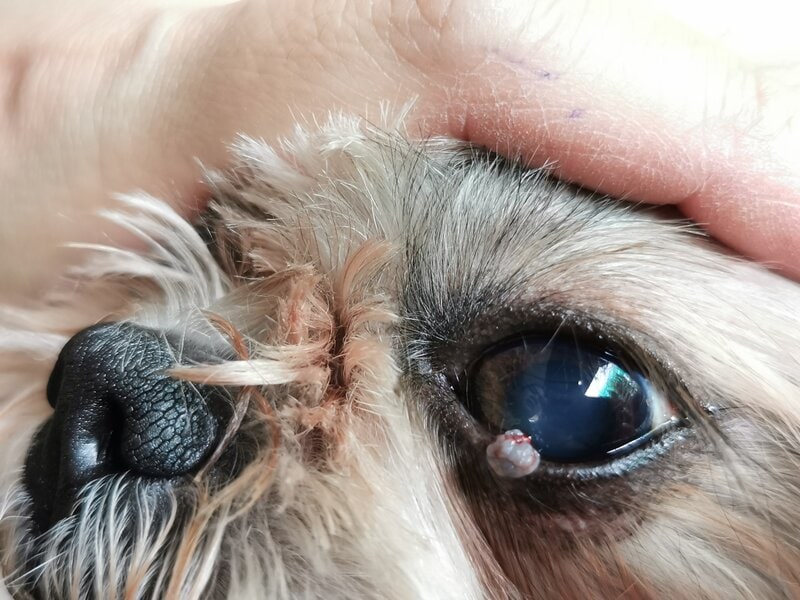
These growths are typically benign in that they do not metastasize to other areas of the body. Most commonly they are adenomas but they can also be classified as epitheliomas.
They can arise from the same glands that chalazion’s develop from. However, these are actual growths, or small tumors. Most commonly these will be non-cancerous. In other words, they do not spread elsewhere but only grow in this one area.
3. Melanoma

Melanomas are cancers that can vary in their aggressive nature. These will frequently appear as black colored swelling and/or masses on the body, including within or on the eye.
Melanomas are caused by the uncontrolled growth of melanocytes. These can start to grow from either the uvea or the limbus of the eye. The uvea of the eye is the inside of the globe, or the eyeball itself. The limbus is the area where the cornea, or surface of the eye and the sclera, or white of the eye, meet.
4. Papilloma

A papilloma is a mass caused by the papilloma virus. These typically are not black or blood-filled but may develop if your dog rubs its face and/or eye, which can cause swelling, bleeding, and crusting of the mass.
Papilloma are wart-like growths that can appear on the skin, eyelids, and conjunctiva from a virus infection. These are most common in younger and/or immunosuppressed animals. The virus will cause one or multiple of the warts to grow on the body and the growths can be of varying sizes. The papilloma virus is species specific and your dog contracts it by direct contact with another infected dog, or a surface where that dog may have left the virus.
5. Trauma/Swelling

If your dog is rubbing their face and/or incurs any type of trauma to their face, they may suffer an abrasion, laceration, or other trauma to their eyelid. This may cause a hematoma, or blood-filled swelling along the eye. Due to the accumulation of blood, these swellings may have a black discoloration.
Any type of trauma to the eye and/or eyelid may cause swelling. Most commonly, we may see a dog who got their eye scratched or poked by another animal or in nature, such as an outside plant. If the trauma occurred to the eyelid and/or the conjunctiva, this area will become inflamed as the body reacts to the wound. Sometimes these areas will become blood filled from the trauma, or crusted and swollen with blood from your dog rubbing at it.

How Do I Care for a Dog With a Bump on Their Eye?
The most important thing to do is make sure your dog’s eye is not painful or irritated. If you notice your dog squinting, holding their eye shut, pawing at their eye, have redness to the sclera (white of the eye), redness and/or swelling to the conjunctiva or a bulging eye, these may all be signs that your dogs’ eye is painful. If this is the case, you should seek veterinary care immediately. Your dog may greatly benefit from a prescription ointment, pain medications or even surgery.
If your dog does not seem bothered by the growth on their eye, it should be monitored, diagnosed, and treated by your veterinarian. They may recommend surgical removal depending on the location of the growth. Or, they may recommend just monitoring it. Often time sampling of the mass is needed to determine if it’s cancerous or not. Because of the location, sedation will likely be needed in order for your veterinarian to safely do this.
Your dog may benefit from wearing an e-collar to prevent them from rubbing at the eye and/or traumatizing it further. These can often be purchased at your regular veterinarian, based on the size of your dog.
It’s important to remember not to put any of your medications into your dog’s eye until they are seen by a veterinarian. Certain ointments can be toxic and/or lead to further damage if it’s not appropriate for your dogs’ condition. You may also read online that you can safely put at-home products such as coconut oil into your dogs’ eye. Please do not apply any medications or oils to your dogs’ eye before speaking to your veterinarian as these products may cause serious damage and even blindness.

Frequently Asked Questions (FAQ)
Does My Dog Need Surgery?
This is something to discuss with your dog’s veterinarian. Depending on the size of the mass and the location, your veterinarian may recommend surgery to remove it. In general, if the mass is growing so that it contacts and/or irritates the cornea, or surface of the eye, then surgical removal will likely be recommended. Your veterinarian may also recommend you have surgery completed by a veterinary ophthalmologist depending on if they have the appropriate surgical tools needed.

Will Both of My Dogs Eyes Be Affected?
This is uncertain. Cancers, whether benign or malignant, can affect one or multiple areas of the body. In general, many malignant growths will just affect one of the eyes. However, there is no way to predict whether or not the other eye may also get a growth.

Conclusion
Bumps on your dog’s eye may seem to appear out of nowhere. Oftentimes, they will have already grown fairly large before you notice them. Depending on how large they are and where they grow, your dog may or may not be bothered by them. The growths can be caused by the papilloma virus, a blocked oil duct, benign or malignant cancers. Only sampling or surgically removing the bumps will give you a diagnosis. Your veterinarian will best be able to advise you if you need to have the bumps surgically removed, or if they should just be monitored and treated medically.
Featured Image Credit: thanwa jundok, Shutterstock
